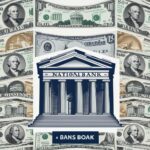
Collapse of a China’s Economy: In a world filled with economic uncertainties, the recent unexpected downturn of a major economy has sent shockwaves through global financial markets. This downturn, characterized by a series of events that were largely unforeseen, has the potential to set off a chain reaction that could lead to the next global financial crisis. In this article, we will delve into the specifics of this economic decline, the factors contributing to it, and its potential consequences on a global scale.
The Precarious Situation Unfolds – Collapse of a China’s Economy
At the heart of this economic turmoil is the People’s Republic of China, a global economic powerhouse that has experienced unprecedented growth over the past few decades. However, as new home prices in 70 Chinese cities began to decline, it became evident that the country’s property sector was heading towards a crisis. This decline in property prices, the steepest in years, raised alarm bells, given the significant leverage within the Chinese housing market. Chinese banks, deeply entwined with property developers, were in jeopardy.
Beijing’s Response: A Planned Economy in Action
In response to this impending crisis, the Chinese government took swift and decisive action. The People’s Bank of China, in conjunction with the national administration of financial regulation and the China Securities Regulatory Commission, issued directives to financial institutions. These directives mandated support for property developers by facilitating loans, issuing bonds, and ensuring equitable financing from capital markets. The government’s firm approach was clear; compliance was not optional in this planned economy.
The Urgency of Bailouts
China’s home prices continued to plummet, and consumer confidence was eroding as a result. As consumers delayed property purchases in anticipation of further price drops, the housing market faced severe challenges. The interconnectedness of Chinese banks and property developers meant that a collapse in the property sector could have far-reaching consequences.
To avert this crisis, regulators encouraged mergers and acquisitions within the real estate sector and called for increased support to ensure the completion of housing projects and the development of affordable homes. The government’s willingness to embrace mergers and acquisitions, typically a subject of antitrust concerns, underscored the urgency of the situation.
The Global Dollar Shortage Dilemma
Beyond the specific issues within China’s property sector, a more profound and global issue loomed—the global dollar shortage. Property developers found it increasingly difficult to meet their dollar-denominated loan obligations, a problem that showed no signs of abating. In response, the Chinese government further intervened by requesting that significant banks cap rates on short-term funding.
This move had significant implications, as national banks were instructed not to offer rates on one-year negotiable certificates of deposit higher than 2.57%. Such rate caps were designed to dissuade savers from holding onto their funds and instead encourage spending—a fundamental strategy in times of economic uncertainty.
The Ripple Effect on Global Markets
The effects of China’s economic downturn extended far beyond its borders. As liquidity concerns spiked and smaller financial institutions resorted to borrowing short-term cash at exorbitant rates, the central bank’s reassurances did little to quell fears. The government’s bond issuance only exacerbated the scarcity of cash in the market, crowding out private sector borrowers and stifling economic growth.
The global economy was already experiencing a slowdown, exacerbated by a global dollar shortage. While the Chinese government’s interventions aimed to prop up its property sector, the root cause of the crisis lay in a broader economic slowdown and liquidity shortages worldwide.
Unforeseen Consequences: The US Housing Market
In the United States, an unexpected twist emerged as new home construction increased in October. Builders appeared confident, believing that consumers would pay almost any price and endure high interest rates to secure a home. This confidence was rooted in the belief that many baby boomers, who owned homes mortgage-free, were reluctant to move and take on new mortgages.
However, the undercurrent of this optimism was the strategy employed by builders to manipulate mortgage rates. Builders used inflated home prices to offset the cost of mortgage rates, effectively passing the burden onto buyers. This approach, while seemingly advantageous in the short term, failed to account for the broader structural issues affecting the US economy.
The Impact of Tightening Bank Standards
Another critical factor contributing to the economic downturn was the tightening of lending standards by banks. Historically, whenever banks tightened lending standards, the housing market experienced a slowdown. The parallel with the 2008 global financial crisis, where banks tightened lending standards amid a slowing housing market, was evident.
As banks tightened standards, it became increasingly challenging for consumers to secure loans for purchasing homes, further dampening demand and exacerbating the economic slowdown. This tightening of lending standards had ripple effects on the housing market, underscoring the fragility of the US economy.
Oil Prices: A Global Indicator
Simultaneously, global oil prices added another layer of complexity to the economic landscape. OPEC’s decision to tighten supply and raise oil prices backfired, sending oil prices on a downward spiral. Despite initial predictions of soaring oil prices, the reality was quite the opposite.
The relationship between oil prices and economic health became apparent as demand for oil waned due to the increase in prices. The dynamics of supply and demand, influenced by OPEC’s decisions and global economic conditions, had a direct impact on oil prices. This further underscored the intricacies of the global economic web.
Falling Import Prices and Inflation
In the midst of these economic challenges, falling import prices presented yet another piece of the puzzle. Import prices in the United States experienced their most significant drop in seven months, reflecting the lower costs of goods entering the country. While policymakers had warned of impending inflation, the data suggested otherwise.
Consumer prices remained unchanged in October, and producer prices even declined, signaling a subsiding trend in inflation. The combination of easing labor market conditions, cooling consumer spending, and falling import prices indicated that the Federal Reserve would likely halt its rate hikes.
UK Retail Sales and Global Sentiment
The economic downturn was not limited to China and the United States. The United Kingdom experienced a surprising decline in retail sales, raising concerns about consumer sentiment and spending. Unusually warm weather, coupled with the rising cost of living and unfavorable weather conditions, contributed to this poor performance.
Consumer sentiment plays a pivotal role in economic stability, and the decline in retail sales in the UK hinted at a broader trend. While some consumers may hold off on spending in anticipation of Black Friday and other festive promotions, the overall level of consumer sentiment remained low, potentially foreshadowing a recession.
The Future of a Major Economy
As we navigate the complexities of this unexpected economic downturn, one thing remains clear—the global economy is facing significant challenges. China’s efforts to stabilize its property sector and the broader implications of the global dollar shortage are just the tip of the iceberg. The intertwined nature of the world’s economies means that a crisis in one major economy can reverberate across the globe.
While some may argue that the American economy is fundamentally strong, the data suggests otherwise. The tightening of bank standards, falling import prices, and subdued inflation all point to a delicate economic situation. Similarly, the decline in UK retail sales underscores the importance of consumer confidence in economic stability.
In conclusion, the unforeseen collapse of a major economy should serve as a stark reminder of the interconnectedness of global financial markets. As we navigate these uncertain waters, it is crucial to monitor economic indicators, adapt to changing conditions, and be prepared for potential challenges that may lie ahead. The road to economic recovery may be fraught with obstacles, but with informed decision-making and coordinated efforts, it is possible to steer the global economy towards a more stable and prosperous future.
Frequently Asked Questions
Q1: What major economy is experiencing an unexpected downturn?
The major economy facing an unexpected downturn is the People’s Republic of China, primarily driven by a decline in its property sector and associated concerns with Chinese banks.
Q2: How is the Chinese government responding to the economic crisis?
The Chinese government is responding by issuing directives to financial institutions to support property developers through loans, bond issuance, and capital market financing. They are also encouraging mergers and acquisitions within the real estate sector to stabilize the housing market.
Q3: What is the global dollar shortage, and how is it affecting the crisis?
The global dollar shortage refers to a situation where there is insufficient US dollars available in the global financial system. It is affecting the crisis by making it challenging for property developers to meet their dollar-denominated loan obligations, leading to liquidity issues.
Q4: How are falling import prices impacting the economy?
Falling import prices are contributing to subdued inflation and easing labor market conditions. This, in turn, is suggesting that the Federal Reserve may halt its rate hikes as consumer prices remain relatively stable.
Q5: What role is consumer sentiment playing in the economic downturn?
Consumer sentiment is crucial in economic stability. A decline in retail sales, as seen in the UK, may indicate lower consumer confidence, potentially signaling an economic recession.
Money posts:
 How Do Banks Make Money? (2024)
How Do Banks Make Money? (2024)
 Cost of Living Michigan: Best Cheapest Places | Ultimate Guide 2024
Cost of Living Michigan: Best Cheapest Places | Ultimate Guide 2024
 Cost of Living Montana: Best Cheapest Places | Ultimate Guide 2024
Cost of Living Montana: Best Cheapest Places | Ultimate Guide 2024
 Best National Banks in the U.S. for 2024
Best National Banks in the U.S. for 2024
 Collab Review – Investing (2024)
Collab Review – Investing (2024)
 Rental Property Due Diligence Checklist (2024)
Rental Property Due Diligence Checklist (2024)
 12 Places to Get a Money Order Near Me (2024)
12 Places to Get a Money Order Near Me (2024)
 Cost of Living Arkansas: Best Cheapest Places | Ultimate Guide 2024
Cost of Living Arkansas: Best Cheapest Places | Ultimate Guide 2024
